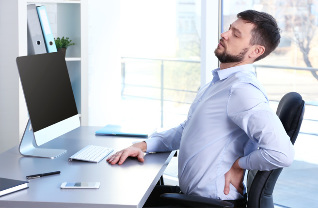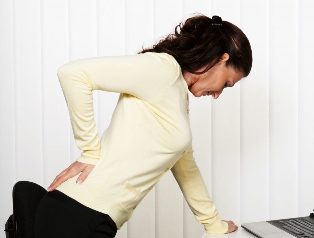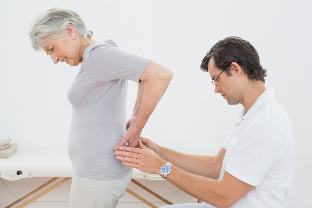
Acute pain in the lumbar region, on the background of osteochondrosis is a common problem faced by the vast majority of people. Which we got "rewarded" for our bipedalism (due to higher axial loads on the spine), this ailments sooner or later affects everyone on the planet, the only question is how fast this occurs and how severe symptoms. Such a "bleak" statistics makes attributed this pathology to socially significant diseases, and the fight against it should not be the responsibility only of the individual suffering from the symptoms of the disease and global health care system as a whole. Therefore, the issue of treatment of osteochondrosis – a topic very relevant.
So what is osteochondrosis? Razglyadev the development of the disease. In its name, if you translate it literally from Latin, certain structures changing during osteoarthritis: bone and cartilage. For the purposes of attenuation and resistance to vertical loads nature has placed between the two vertebrae is a kind of fibro-cartilage "cushions" — the intervertebral discs. Their food is carried out in childhood due to the blood vessels, which lost about 25 years, and the food begins to be diffuse due to the surrounding muscles.
During pathological loading on the spine (sedentary work, or excessive exercise), a violation of the processes of mineral exchange, the intervertebral disc loses its elastic and damping properties, reduced height, changes the structure of the vertebrae, the connection has a pathological bony growths (osteophytes and zamechatelnye plates), impaired mobility in the affected section of the spine. In the later stages of disease the Central portion of the intervertebral disc called the nucleus pulposus, breaking the fibrous ring, forms a kind of saccular protrusion between bodies of vertebrae — intervertebral hernia. Herniation can cause compression of the nearby nerve roots of the vertebrae, there is intense pain in the area of compression, as well as in the field, which is governed by the work of the affected nerve. Due to the constant irritation of the nerve plexus there is a reflex spasm of the skeletal muscles, in medicine titles protective defense that one side suffers protects the spine from excessive movements, and on the other hand increases the compression, swelling and pain in the affected area.
In the majority of cases (90%) the pain syndrome in osteochondrosis (even very distinct) m anovim due to spasm! In other cases, the cause of the pain is the compression of the nerve root or the spinal cord directly a herniated disc.
Osteochondrosis of the lumbar spine: how to treat
From all parts of the spine, and there are five of them (cervical, thoracic, lumbar, sacral, and coccygeal), due to the largest motor load from the manifestations of the illness lumbar. Osteochondrosis of the lumbar spine is bright, all the familiar symptoms, and treatment it is an important social problem because it affects the quality of life not only of the elderly but active people of working age.

Pain can be localized directly in the lumbar region, and also on the front of the thigh, or across the back or outer surface of the leg, sometimes to my fingers. Often give pain in the gluteal region, pelvis, perineum, and sometimes can be localized only in these areas, masquerading as diseases of the urogenital system and intestines and making it difficult the correct diagnosis. The pain intensity may be so high that a person loses the ability to perform the most basic movements, adopt forced postures and loses normal sleep. That much of the sciatica, which in wide circles long ago became synonymous with the disease itself.
Limitation of physical activity. Violated the usual movement and sensitivity in the extremities, there are m Azov cramps, paresthesia (tingling sensation, burning sensation of pins and needles").
Dysfunction of pelvis organs. With intensive radicular syndrome is known as sciatica, or massive Grajewo the protrusion can be violated even urination and bowel, causing severe agony to the patient.
Treatment of degenerative disc disease of the lumbar spine often becomes challenging for both patient and doctor. Every person suffering from this disease were asked the following questions: "How to treat lumbar degenerative disc disease?", "How to treat osteochondrosis of the lumbar spine?", "If the treatment of degenerative disc disease of the lumbar at home doesn't help – which doctor to draw?", "If the pills and ointment for lumbar disc disease does not help - how to treat?".
To cope with the aggravation of degenerative disc disease and prescribe an effective treatment will help such doctors: therapist, neurologist, specialist in medical massage, chiropractor, physical therapist, and if necessary, surgical treatment – doctor neurosurgeon.
Can struggle with degenerative disc disease of the lumbar spine
The main thing in the treatment of degenerative disc disease is the right way of life! People actively and properly engaged in physical culture and follow the spine, the back never hurts! Unfortunately, few people comply with these simple truths.
Examining these questions, we can distinguish:
- medication;
- drug-free.
Non-pharmacological methods of treatment of pathology of the lumbar spine
Distraction procedures. Their effect lies in the name itself - the use of different applicators, massage mats and cushions, woolen belts, "widgets" and "friction" due to the impact on surface nerve endings and blood vessels reduces m atovi spasm and pain. These methods can be used as an auxiliary, but insulated their use during exacerbation of osteochondrosis of lumbar segment without systemic treatment with special medicines ineffective.
Means of immobilization. Under these tools understand the bandages different designs, the wearing of which allows to protect the spine from sudden and dangerous movements and to redistribute the load if static work. Means of immobilization can be purchased at medical equipment stores and pharmacies however before purchasing advisable to consult a doctor who will help determine the best in your situation design, the stiffness and configuration of the bandage. It is advisable to apply them only one hour of exposure to adverse factors (driving, sedentary work, etc.), as prolonged use causes wasting of the muscles.
Physiotherapy (physical therapy) – there is a removable component of the complex treatment of degenerative disc disease. The exercise, aimed at maintaining the tone of skeletal muscle the keeps and removal of pathological soft muscle spasm to help restore and sustain physical activity, reduction of pain syndrome intensity. A significant plus physical therapy is that after learning instructor the person can independently perform daily exercises at home, and in the existence of a set of exercises that apply even during exacerbation of the process. The most effective means of physical therapy are therapy sessions in the gym on individually developed technique, because the formation of soft muscles necessary to work with the weights.
Massage known for a long time, the most common and perhaps the most beloved by patients the way of prevention and treatment, however in the phase of exacerbation of osteochondrosis of lumbar segment cannot be used. In addition, to massage with osteochondrosis should only be a specialist with medical education, perfectly knows anatomy and physiology and owns the technique that is medical massage.
Chiropractic and comes in popularity in recent years osteopathy is performed by a competent professional can have a significant therapeutic effect and even for a longer period to get rid of exacerbations. It is also important to remember that turning to a chiropractor before beginning the procedures necessary to conduct instrumental examinations of the spine (x-rays, CT or magnetic resonance imaging, osteodensitometry) in order to allow the doctor to assess the prevalence and severity of process and to exclude possible contraindications to manipulation. Like massage, chiropractic and osteopathy are a number of contraindications, such as severe compression of the nerve root by the herniation, subluxation of the vertebrae. In the acute stages of degenerative disc disease of the lumbar is usually used, what techniques of manual therapy (muscle relaxation, etc.).
Acupuncture. According to recent studies, the use of this popular in wide circles of the methodology evidence-based medicine is considered to be unreasonable in osteochondrosis of the lumbar spine, does not eliminate the symptoms of the disease, and refers to alternative methods of treatment.
The physical therapyincluded in national clinical guidelines and standards of medical care in osteochondrosis, has long proved its effectiveness in the treatment of this disease. Osteochondrosis of the lumbar spine applied electromyostimulation, amplipulse therapy, shock wave therapy, interstitial myostimulation, laser. A popular method in the complex treatment remains magnetic. Its advantages include good tolerance and a small list of contraindications, possibility of application in the acute period of the disease. Acting on all links of the pathological process it already after a few treatments significantly reduces pain and allows a person to expand physical activity. In addition, by improving the trophism of the affected tissue it slows down the progression of the disease. A clear advantage of this method is the possibility of its independent use by the patient outside of a medical institution.
But if all these non-pharmacological methods have been ineffective - then what to treat lumbar degenerative disc disease?
Medication
Disease provides for the appointment of the following drug groups:
Nonsteroidal anti-inflammatory drugs (NSAIDs) are available in the local forms (gels, ointments, creams) and systemic treatment (tablets, suppositories, solutions for nutria m Azuaga and intravenous). Their action is based on blocking the inflammatory process on enzymatic level due to eliminating swelling in the affected area and significantly reduced pain.
In the early stages of the disease is enough local application of NSAIDs in combination with non-pharmacological methods (physiotherapy, magnetotherapy). When expressed pathological process and intense pain to have to resort to tablets, and sometimes injections of drugs.
Sorry, have a good anti-inflammatory and analgesic effect of NSAIDs, long-term systemic use can cause the development and worsening of ulcerative and erosive processes of the gastrointestinal tract, and impaired kidney and liver. Therefore, patients who for a long time, take NSAIDs, the drugs that protect the stomach lining and regular laboratory monitoring of the performance of the liver and kidneys.
The system muscle relaxants, that is, drugs that release m atovi spasm. The principle of their action lies in the name: relaxation of spastic muscles reduce the compression of nerves and blood vessels, swelling in the affected area – improves blood circulation and lymph drainage – reduces pain by reducing défense, reduced muscle stress when the binding apparatus reduces the bulging (protrusion) of the intervertebral disc – simmering pain, increases range of motion.
Muscle relaxants for treatment of osteochondrosis, are produced in the form of tablets and solutions for nutria m asewage of administration, to achieve therapeutic effect should be long and gradually increasing the dose. Also as NSAIDs, muscle relaxants have a number of contraindications and can cause unwanted side effects that is why, despite the free sale in drugstores, before purchasing you should consult with your doctor.
Local anesthetics or medications for local anesthesia used for medical treatment of lumbar osteochondrosis in the form of so-called paravertebral blockade, when the solution of the drug administered first subcutaneously, and then in the processes of the affected vertebra in the projection of the anticipated compression of a nerve root.
Accumulate in the membranes of nerve fibers, the drug effectively blocks pain signal. Therapist, of course, to perform such a blockade can not, it is necessary to consult a neurologist or neurosurgeon.
For paravertebral injection are sometimes used solutions of glucocorticosteroids (GCS) - hormonal drugs, has a pronounced anti-inflammatory action. Local their application allows to achieve the maximum effect with the minimum risk of undesirable side effects of the drug. Such closures are held courses 2-3 times a year, to fulfill their needs a neurologist or a physician neurosurgeon.
Vitamins of group "b". In any pharmacy you will be able to know a variety of drugs of this group as in the forms for oral administration, and for unotron m Azuaga introduction. They are believed to have neurotrophic and easy analgetic effect, but reliable justify their use in osteochondrosis of the spine evidence-based medicine is not obtained.
Physical therapy in osteochondrosis of the lumbar

Unfortunately, sometimes complex treatment with application of modern medicines, physiotherapy, massage and exercise therapy is ineffective – the person continues to feel pain, there is the limitation of physical activity significantly affects the quality of life. It happens in the later stages of the disease when formed unions of separable, often gryzenia multiple protrusions of intervertebral disks. In this situation, surgical treatment is indicated. Additionally, surgical intervention is indicated for the so-called "prolapse of the hernia" when a significant compression of the spinal canal causes pain nekupirutayasa, static-dynamic violations and the blockade of the functions of the bladder and intestines. In such cases the operation is performed on an emergency basis. The purpose of surgical interventions for degenerative disc disease of the lumbar spine is a mechanical decompression of the spinal canal and nerve roots.
Currently, the surgical treatment of degenerative disc disease are used as the long-known Association of detachable surgical techniques and modern medicine minimally invasive endoscopic procedures using laser and RF exposure, some of which can be carried out even under local anesthesia.
Having examined the basic can treatment of degenerative disc disease of the lumbar spine, I want to reiterate that the patient, who is wondering "how to treat lumbar degenerative disc disease?", should hope not only medical help but also on our own strength, realizing the importance of a healthy lifestyle, which encouraged proper nutrition is applied correctly dosed physical load, and most importantly, there is faith in victory over the disease.
































